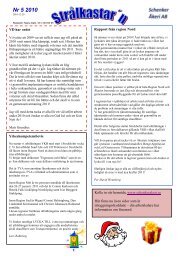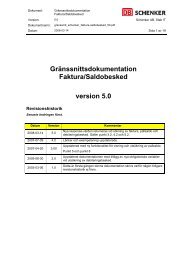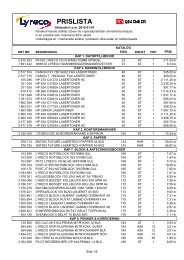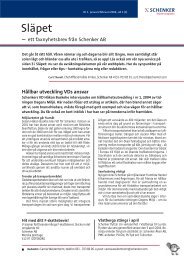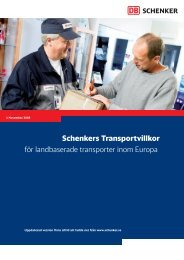Ecological Transport Information Tool for Worldwide ... - Schenker
Ecological Transport Information Tool for Worldwide ... - Schenker
Ecological Transport Information Tool for Worldwide ... - Schenker
You also want an ePaper? Increase the reach of your titles
YUMPU automatically turns print PDFs into web optimized ePapers that Google loves.
IFEU Heidelberg, Öko-Institut, IVE, RMCON Page 69<br />
Table 42<br />
Characteristics of selected aircrafts<br />
Type<br />
Distance<br />
Group<br />
Type of<br />
aircraft<br />
Aircraft<br />
code<br />
Design<br />
Range<br />
(km)<br />
Max. Payload<br />
(t)<br />
Typical<br />
Seats<br />
(number)<br />
Freighter Short haul Boeing 737-200C B732F 2,240 17.3<br />
Freighter Medium Haul Boeing 767-300F B763F 6,025 53.7<br />
Freighter Long haul Boeing 747-400F B744F 8,230 112.6<br />
Belly Freight Short haul Fokker 100 F100 3,170 1.0 85<br />
Belly Freight Medium Haul Boeing 757-200 B752 7,222 4 200<br />
Belly Freight Long haul Boeing 747-400 B744 13,450 14 416<br />
Sources: Lang 2007; Lufthansa Cargo 2007..<br />
As mentioned mainly high value volume or perishable goods are shipped by air freight and the<br />
permissible maximum weight is limited. There<strong>for</strong>e only the category volume goods is included<br />
within the EcoTransIT World tool. Other types of goods (bulk, average) are not available. The<br />
load factors used <strong>for</strong> volume goods differentiated by short, medium and long haul are contained<br />
in chapter 3.2.3.<br />
5.5.2 Energy consumption and emission factors<br />
Specific energy consumption and emissions of air cargo transportation depend heavily on the<br />
length of the flight. This is caused by different energy needs in different phases of flight. For<br />
example the take-off has the highest specific energy demand. Its share of the total flight obviously<br />
declines as the length of the flight increases. Hence EcoTransIT World contains fuel<br />
consumption and emission data of each airplane including their flight distance dependence.<br />
Furthermore, energy consumption and emissions depend on utilization of the capacity of aircrafts<br />
(load factor). Whereas this dependency is considered by road transport, this was not<br />
able <strong>for</strong> aircrafts due to lack of available data. But the possible error is small and from there<br />
justifiable.<br />
The basis of fuel consumption and emission data is the CORINAIR Emission Inventory<br />
Guidebook /EEA 2006/. This guidebook includes detailed in<strong>for</strong>mation of fuel burned as well as<br />
NOx and HC emissions associated with discrete mission distances and <strong>for</strong> approximately 20<br />
different turbojet aircraft types. The CORINAIR database uses modelled data derived from the<br />
aircraft per<strong>for</strong>mance model PIANO3. The data of the CORINAIR Guidebook was applied in<br />
different emission calculation tools and handbooks /ICAO 2008, DEFRA 2008/ and it is also<br />
used <strong>for</strong> EcoTransIT World. In this context, it has to be taken into account that the CORINAIR<br />
data is based on an average fleet. The calculated values may be 10% below or above the real<br />
fuel consumption and emissions of individual aircrafts connecting a concrete city pair /ICAO<br />
2008/. Although most air carriers have detailed in<strong>for</strong>mation of their fuel consumption and<br />
emissions, this data is not made available to the public. Thus the CORINAIR data is the best<br />
publicly available data source <strong>for</strong> the purpose of EcoTransIT World.<br />
Table 43 shows CORINAIR energy consumptions <strong>for</strong> aircrafts selected <strong>for</strong> the standard modus<br />
of EcoTransIT relating to discrete travel distances. Fuel data of other aircrafts covered by<br />
EcoTransIT can be found in Table 59 in the annex. Since CORINAIR database contains only<br />
EcoTransIT World: Methodology and Data – July 15 th , 2010




